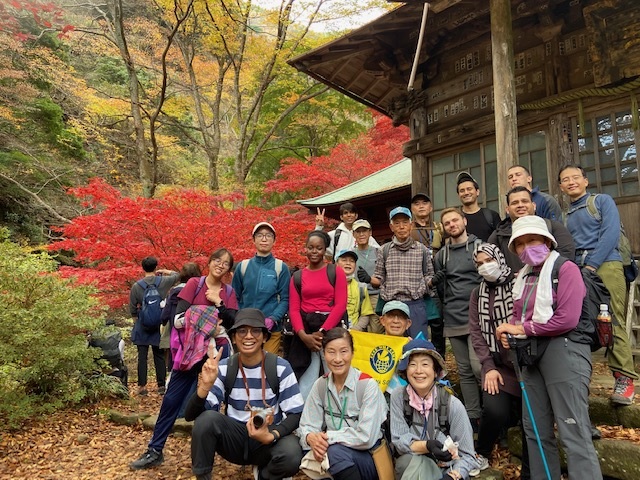Date & Time: Sunday, November 27, 9 AM to 3 PM
Spots: Mt. Oyama Hiking Trail
Took a bus from Isehara Sta. to Oyama bus stop. Walked through lodging areas and Koma-sando shopping alley to Onna-zaka Slope Entrance (elev. 400 m). Walked up the steep slope through Oyama temple and Oyama shrine to Miharashidai viewpoint (elev. 765 m).
Participants: Sowou from Africa and nine foreign students*, accompanied by nine KSGG hiking guides.
Report by Thomas, KSGG
Sowou is an international student from Togo in western Africa. She originally came from a farming village and finished a college in Lomé, the capital of the country. She majors in agricultural economics at the graduate school of the University of Tokyo on a scholarship from JICA**. Sowou speaks English frequently as well as French and her mother tongue. She is a brilliant girl. Most of the land in Togo is flat Savanna. Today she goes on a hike in high mountains for the first time in her life.
The trail from the bus stop to the Onna-zaka entrance slopes up gradually. On the way, a KSGG guide told her that the two religions, domestic Shinto and foreign Buddhism, had been co-existing peacefully for long time in Japan. Since the eighteenth century, a lot of commoners came from Edo (current Tokyo) to Mt. Oyama to visit the shrine and temple. In old days, mountain priests climbed up the steep ridges and peaks in Mt. Oyama in order to strengthen themselves physically and mentally, and chanted prayers. On the trail Sowou saw a number of remnants of the old history of Mt. Oyama such as water falls where visitors purified themselves, stone statues of deities, wooden temple buildings, and seven wonders of Mt. Oyama.
After warm-up exercise, Sowou walked up the Onna-zaka (female) slope. She took off her jacket as she got sweaty. Though the Onna-zaka was not so arduous as the Otoko-zaka (male) slope, another path, the female route was still quite steep and had a lot of steps. Most of the guides were in the generation of the parents of the students. The hiking party was an interesting mix of young and old people. The guides energetically led the student hikers. Sowou walked upward the hilly path, taking a rest from time to time. At the end of Onna-zaka slope, the hikers finally take a lunch break. Sowou ate a lunch box of beef, potatoes, and green peppers that she cooked, while others had sandwiches or onigiri rice balls that they bought.
Mt. Oyama is famous for its autumn leaves. The students said they’d never seen such beautiful colors, as most of them were from the tropical countries that don’t have four-seasons. The color of leaves in Europe, which is located in higher latitude, may turn yellow, but never become red, said a German student. From the Oyama shrine at the halfway up of the mountain, the hikers enjoyed the Michelin-2-stars view of the Pacific Ocean, its coast line, and Enoshima island on top of the autumn leaves. It was a fine day and the weather was perfect for outing. The mountain should record the greatest number of visitors on the day in the season. As she felt exhausted a bit, Sowou wondered about if she should take a cable car to go down on the way back. She decided to continue walking. At the end of the day, she said, “I think it will be good for my health!”
*Students are from Brazil, China, Egypt, Germany, India, Indonesia, Nicaragua, Pakistan, Togo, and Vietnam.
**Japan International Cooperation Agency
